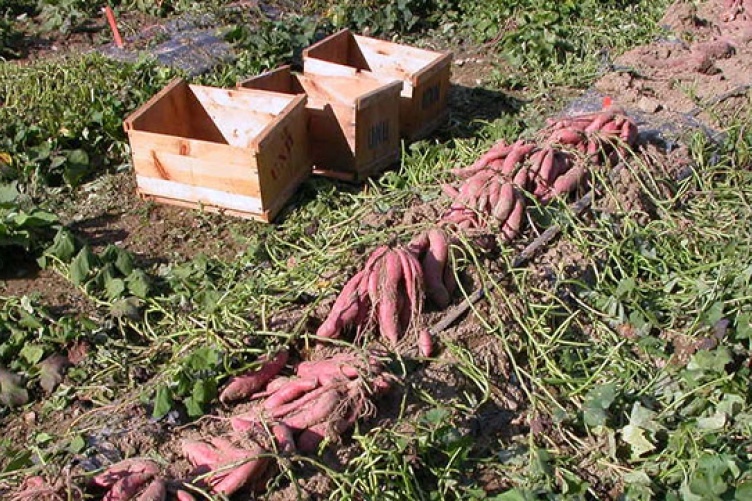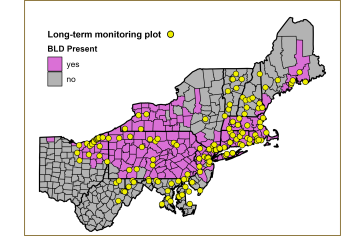
The cultivar Covington produced high yields of sweet potatoes.
In the first study of the performance of modern sweet potato cultivars in northern regions, University of New Hampshire researchers have found that sweet potatoes can be a viable crop for growers in areas with short growing seasons such as New England.
“The results of this study show that sweet potato is a viable crop for New Hampshire as well as other northern states of United States. We demonstrated the potential to produce high yields of high-quality sweet potatoes, despite our relatively short growing season,” said Becky Sideman, a researcher with the New Hampshire Agricultural Experiment Station and UNH Cooperative Extension professor of sustainable horticulture production.
From 2007-2012, sweet potato acreage throughout the New England states increased more than eight-fold from 4 to 33 acres, all for fresh-market sales with most individual producers having small plantings of less than half an acre, according to the U.S. Department of Agriculture.
Sideman evaluated the performance of several sweet potato cultivars grown on raised beds covered with biodegradable black mulch at the UNH Woodman Horticultural Research Farm, a facility of the New Hampshire Agricultural Experiment Station. Six cultivars were evaluated over four years, and an additional four cultivars were evaluated for two or three years.
The different cultivars showed significant differences in marketable yield, percent cull, and percent small roots. The cultivars Covington and B94-14 Beauregard consistently produced high yields whereas Vardaman consistently produced the lowest yields. Georgia Jet exhibited variable performance with marketable yields among the highest in one year and the lowest in another, largely because of a high percentage of cull roots due to severe cracking.
Despite a relatively short growing season, the highest-yielding cultivars in each year produced marketable yields ranging from 503 to 887 50-pound bushels per acre. This compares favorably with national average yields, which range from 310 to 550 bushels per acre depending on the state, with an overall average of 438 bushels per acre, according to the U.S. Department of Agriculture.
“Direct-market sales are the primary outlet for growers in our region, and locally grown sweet potato can enhance growers’ fall and winter offerings. We recommend Beauregard and Covington as orange-fleshed cultivars that produce consistently high yields,” Sideman said.
Lori Schreier of Fertile Fields Farm in Westmoreland said her farm has a loyal following of sweet potato customers at farmers markets. “People are always asking when they will be ready for sale. They are being recognized as a superfood, and people around here want to eat them more,” she said.
Fertile Fields Farm has been growing sweet potatoes for seven years and has sought out Sideman’s advice throughout the years on issues such as the condition of plants, fertilizer choices, use of plastic or row cover, and best planting practices.
“Sweet potato research is very helpful and valuable to us as it helps us to make good decisions which grow better sweets and find the best ones to grow. The more choices we can grow locally, the better. People want local food from farmers they know. The 100-day sweets seems to do well in our climate, except for those cool wet summers, which I think we are having now. But wait, that could change any minute,” she said.
Bruce Wooster, owner of Picadilly Farm in Winchester, also has been working with Sideman to grow sweet potatoes. “Becky's research has been great for us, and already influenced what we do and know about variety selection, plant spacing, and tuber storage. Demand has been strong for us every year we've grown them -- since 2007 at this farm,” Wooster said.
The research was funded by the New Hampshire Agricultural Experiment Station, New Hampshire Vegetable and Berry Growers’ Association, and the New England Vegetable and Berry Growers’ Association. The research findings are reported in the June 2015 issue of HortTechnology in the article “Performance of Sweetpotato Cultivars Grown Using Biodegradable Black Plastic Mulch in New Hampshire.”
This material is based upon work that is supported by the National Institute of Food and Agriculture, U.S. Department of Agriculture, under award number 228522.
Founded in 1887, the NH Agricultural Experiment Station at theUNH College of Life Sciences and Agriculture is UNH’s original research center and an elemental component of New Hampshire's land-grant university heritage and mission. We steward federal and state funding, including support from the USDA National Institute of Food and Agriculture, to provide unbiased and objective research concerning diverse aspects of sustainable agriculture and foods, aquaculture, forest management, and related wildlife, natural resources and rural community topics. We maintain the Woodman and Kingman agronomy and horticultural farms, the Macfarlane Greenhouses, the Fairchild Dairy Teaching and Research Center, and the Organic Dairy Research Farm. Additional properties also provide forage, forests and woodlands in direct support to research, teaching, and outreach.
-
Written By:
Lori Tyler Gula, PhD | NH Agricultural Experiment Station | lori.gula@unh.edu | 603-862-1452



















































